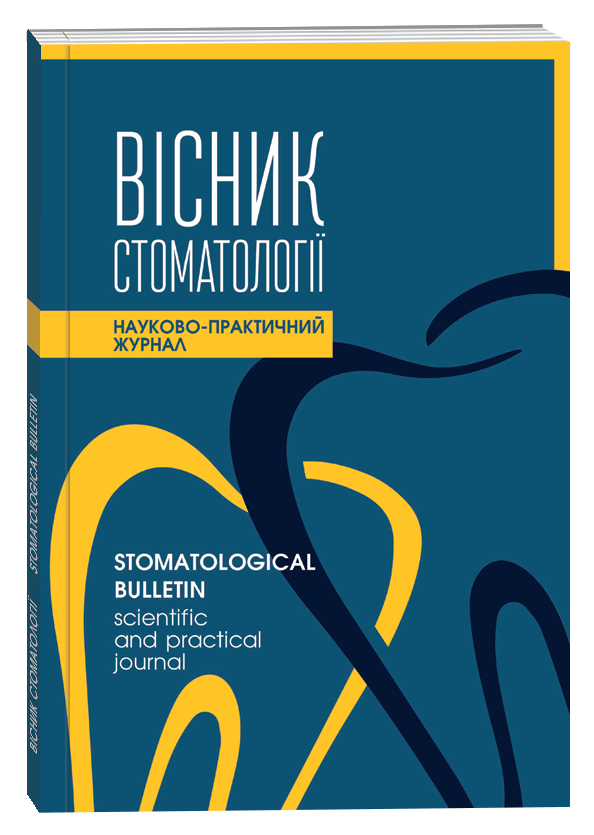STATUS OF REGIONAL BLOOD SUPPLY IN PERIODONTAL TISSUES IN PATIENTS WITH MAXILLOMANDIBULAR ANOMALIES ON THE BACKGROUND OF ARCHITECTONIC DISORDERS OF THE VESTIBULE OF THE MOUTH IN THE COURSE OF COMPLEX TREATMENT
DOI:
https://doi.org/10.35220/2078-8916-2023-47-1.28Keywords:
dental anomalies, buccal frenulum, frenulum of lips, plastic in the vestibule of the mouth, blood supply.Abstract
The aim of the study. To study of the state of regional blood supply in the tissues of the vestibule of the mouth maxillomandibular anomalies on the background disorders of the architectonics of the vestibule of the mouth Research methods. 60 patients with maxillomandibular anomalies and disorders of the architectonics of the vestibule of the mouth were examined and treated. The age group of patients is 9-12 years old. The first group consisted of 30 patients who had plastic surgery of connective strands by the classical method, where the wound was healed by secondary tension. In group 1A (15 people) in the postoperative period, chlorhexidine-denta was prescribed, in group 1B (15 people) – chlorhexidine-denta and gengigel. In the second group (30 patients), plastic surgery of connective strands were performed using our proposed method, where the wound heals by primary tension. In group 2A (15 people) in the postoperative period, chlorhexidine-denta was prescribed, in group 2B (15 people) – chlorhexidine-denta and gengigel. In comparison group where were 15 persons without maxillofacial anomalies, deformities, oral habits and periodontal status. All patients underwent rheography of the vestibule of the mouth with the help of the following devices and programs: Rheograph “DX”, “DX-Complex Regina 2002”. Rheoelectroencephalograph was a recording device. The study was conducted before treatment and after surgical correction (1 month, 6 months, 12 months). Scientific novelty. The results of the study of the regional blood circulation of the tissues of the vestibule of the mouth showed a lack of blood circulation and a decrease in tissue trophicity, which is indicated by the qualitative and quantitative characteristics of rheogams (p<0.05). Qualitative indicators of rheograms were correlated with quantitative characteristics. After the treatment, positive dynamics of rheographic indicators were observed in all groups, however, the normalization of indicators was observed with a significant difference in the 2B group of patients (p<0.05). Conclusions. In patients with maxillomandibular anomalies and disorders of the architectonics of the vestibule of the mouth, there are changes in the blood supply in the tissues of the vestibule of the mouth. After the surgical treatment, normalization of blood supply was diagnosed in all groups of patients. However, stabilization of indicators in the early and longterm follow-up was diagnosed in patients of the 2B group.
References
Базунова И. В. Влияние состояния преддверия рта у лиц молодого возроста на выбор тактики стоматологических вмешательств: дис. … канд. мед. наук: 14.00.21 «Стоматология». Полтава, 2007. 159 с.
Makhlynets NP Rheological changes of the mucous membrane of the mouth vestibule on the vestibuloplasty background. Galytskyy likarskyy visnyk. 2015; 22 (4): 48-51.
Пономаренко ВО, Силенко ЮЛ, Хребор МВ, Хміль ТА. Стан регіонарного кровообігу тканин ротової порожнини у осіб старечого віку на етапах імплантаційного лікування. Український стоматологічний альманах. 2013. № 5. С. 81-84.
Barry O, Wang Y, Wahl G., et al. Determination of baseline alveolar mucosa perfusion parameters using laser Doppler flowmetry and tissue spectrophotometry in healthy adults Acta Odontol Scand. 2020; 78(1): 31-37. doi: 10.1080/00016357.2019.1645353.
Bhati A, Fageeh H, Ibraheem W. Role of hyaluronic acid in periodontal therapy Biomedical report. 2022: 17: 1-5. https://doi.org/10.3892/br.2022.1574
Casale M, Moffa A, Vella P, Sabatino L, Capuano F, Salvinelli B, Lopez MA, Carinci F and Salvinelli F: Hyaluronic acid: Perspectives in dentistry. A systematic review Int J Immunopathol Pharmacol. 2016; 29: 572–582. doi: 10.1177/0394632016652906.
Carlson GA, Dragoo JL, Samimi B, Bruckner DA, Bernard GW, Hedrick M and Benhaim P: Bacteriostatic properties of biomatrices against common orthopaedic pathogens. Biochem Biophys Res Commun. 2004; 321:472–478. doi: 10.1016/j.bbrc.2004.06.165
Eeckhout C, Ackerman J, Glibert M, Cosyn J.A randomized controlled trial evaluating hyaluronic acid gel as wound healing agent in alveolar ridge preservation. J Clin Periodontol. 2022; 49(3):280-291. doi: 10.1111/ jcpe.13589.
Forthofer R. N. Biostatistics: A Guide to Design, Analysis, and Discovery. Amsterdam: Elsevier Academic Press, 2007: 502.
Ibraheem W, Jedaiba WH, Alnami AM, Hussain Baiti LA, Ali Manqari SM, Bhati A, Almarghlani A and Assaggaf M: Efficacy of hyaluronic acid gel and spray in healing of extraction wound: A randomized controlled study. Eur Rev Med Pharmacol Sci. 2022; 26:3444–3449. Doi: 10.26355/eurrev_202205_28838
Kouadio AA, Jordana F, Koffi NJ, Le Bars P, Soueidan A. The use of laser Doppler flowmetry to evaluate oral soft tissue blood flow in humans: A review Arch Oral Biol. 2018; 86: 58-71. doi: 10.1016/j. archoralbio.2017.11.009.
Marconati M, Ramaioli M The role of extensional rheology in the oral phase of swallowing: an in vitro study. arXiv. 2020; 1: 1-16.
Nakamura M, Hikida M, Nakano T, Ito S, Hamano T and Kinoshita S: Characterization of water retentive properties of hyaluronan. Cornea. 1993; 12: 433–436. doi : 10.1097/00003226-199309000-00010
Prosdocimi M, Bevilacqua C Exogenous hyaluronic acid and wound healing: an updated vision Panminerva Med 2012; 54(2):129-35.








